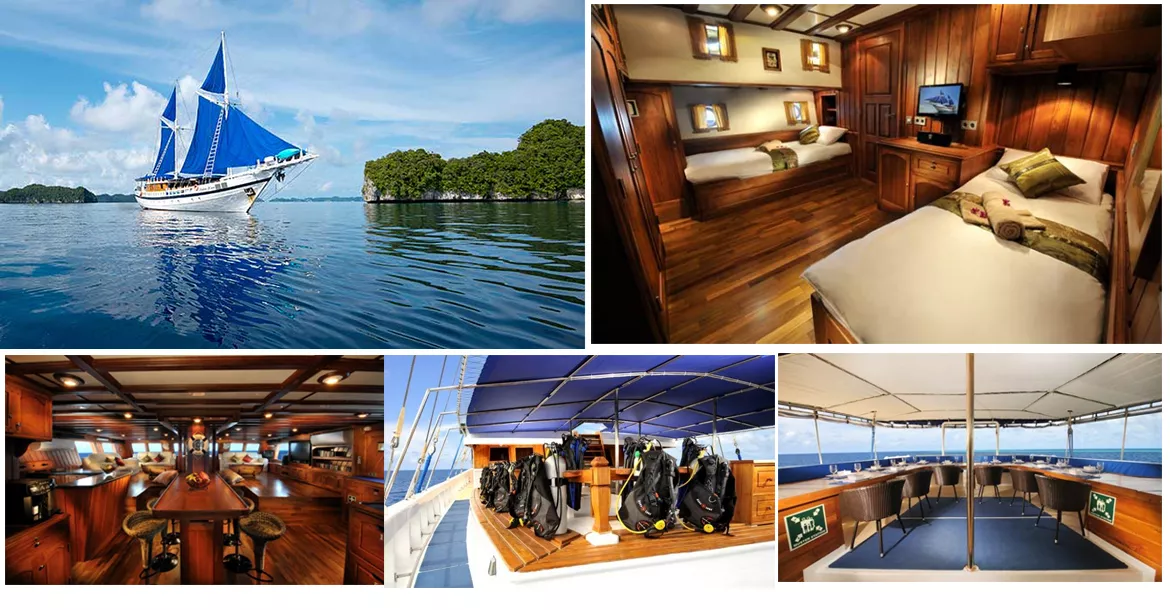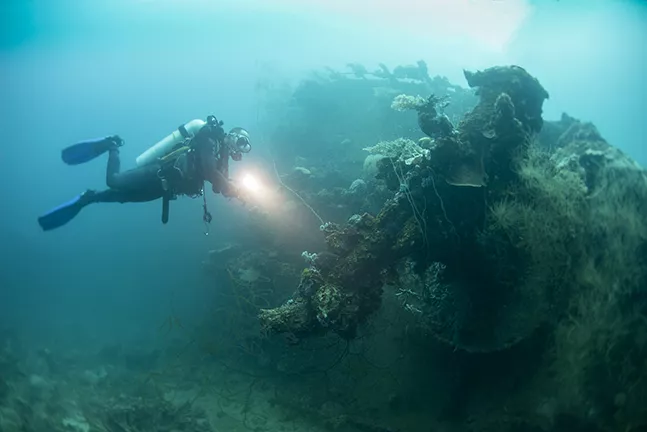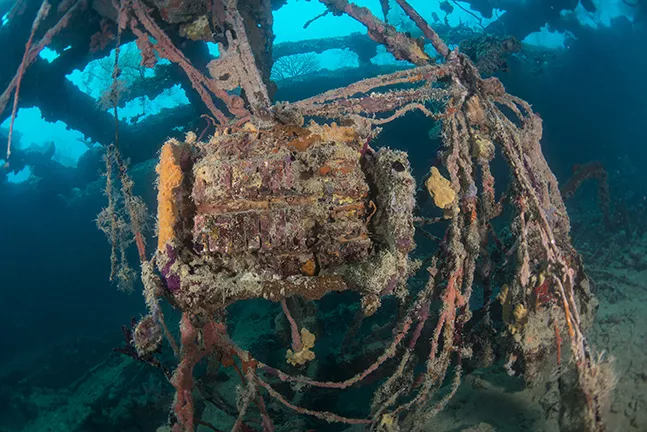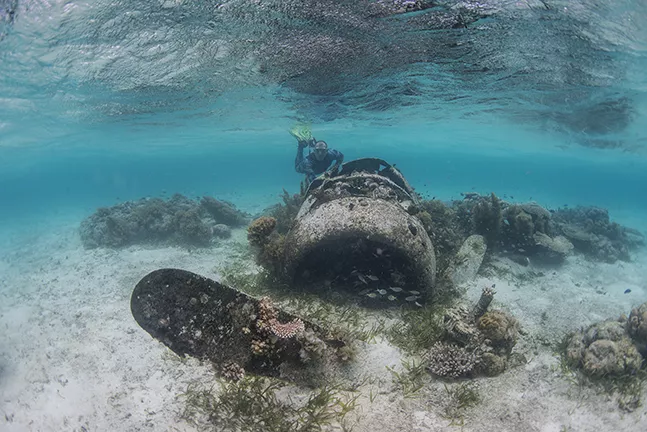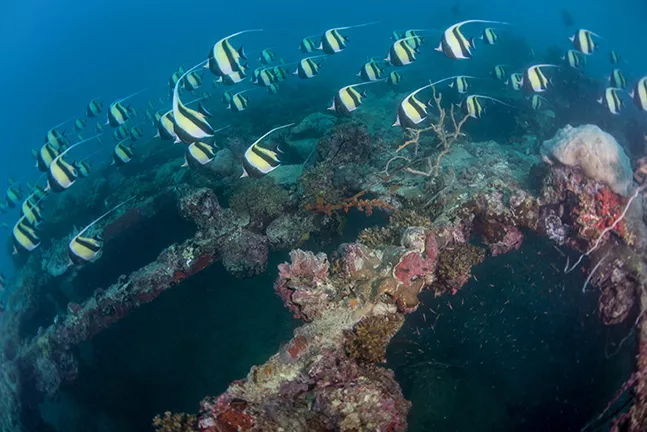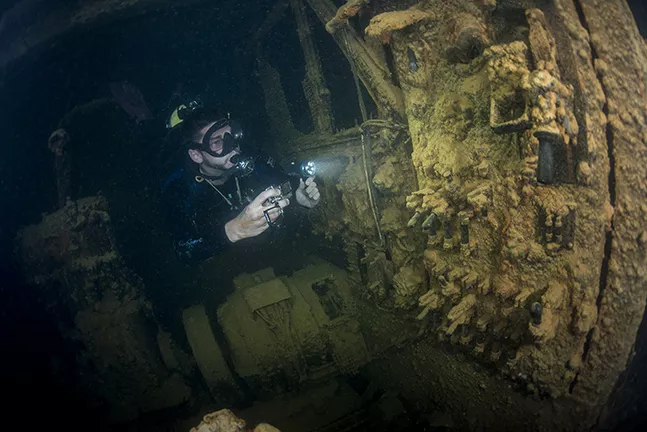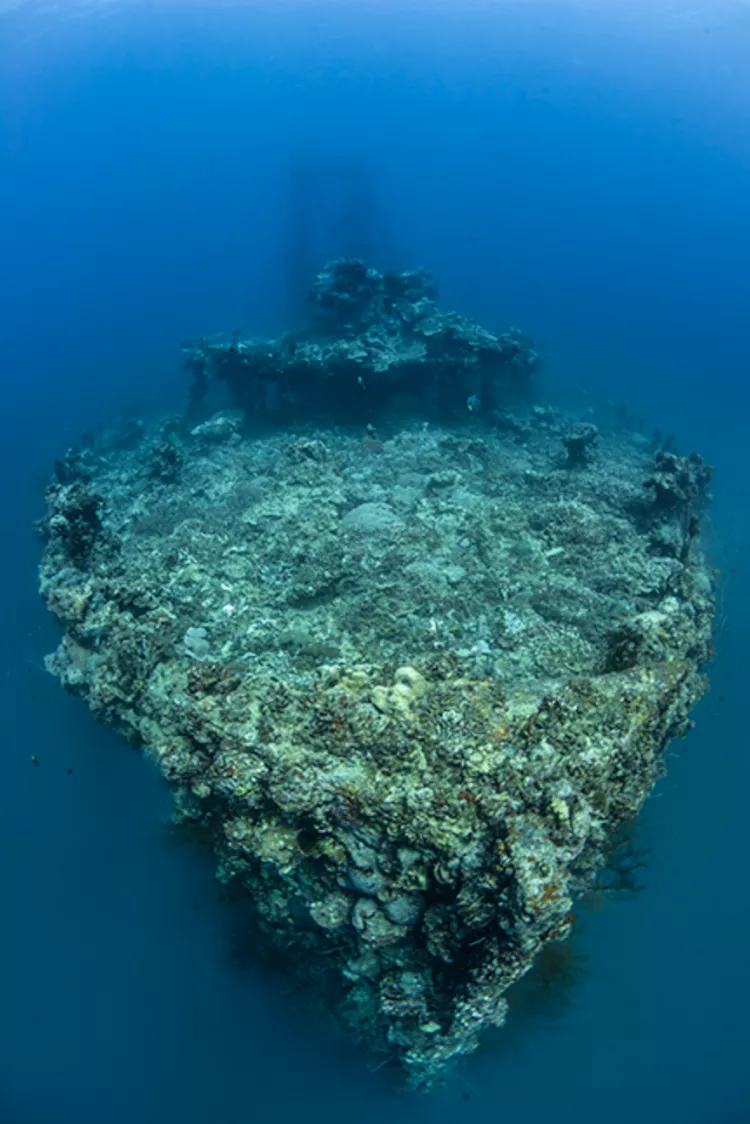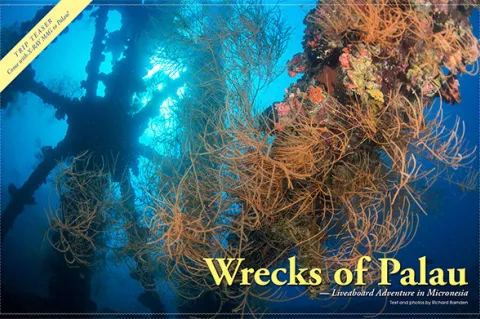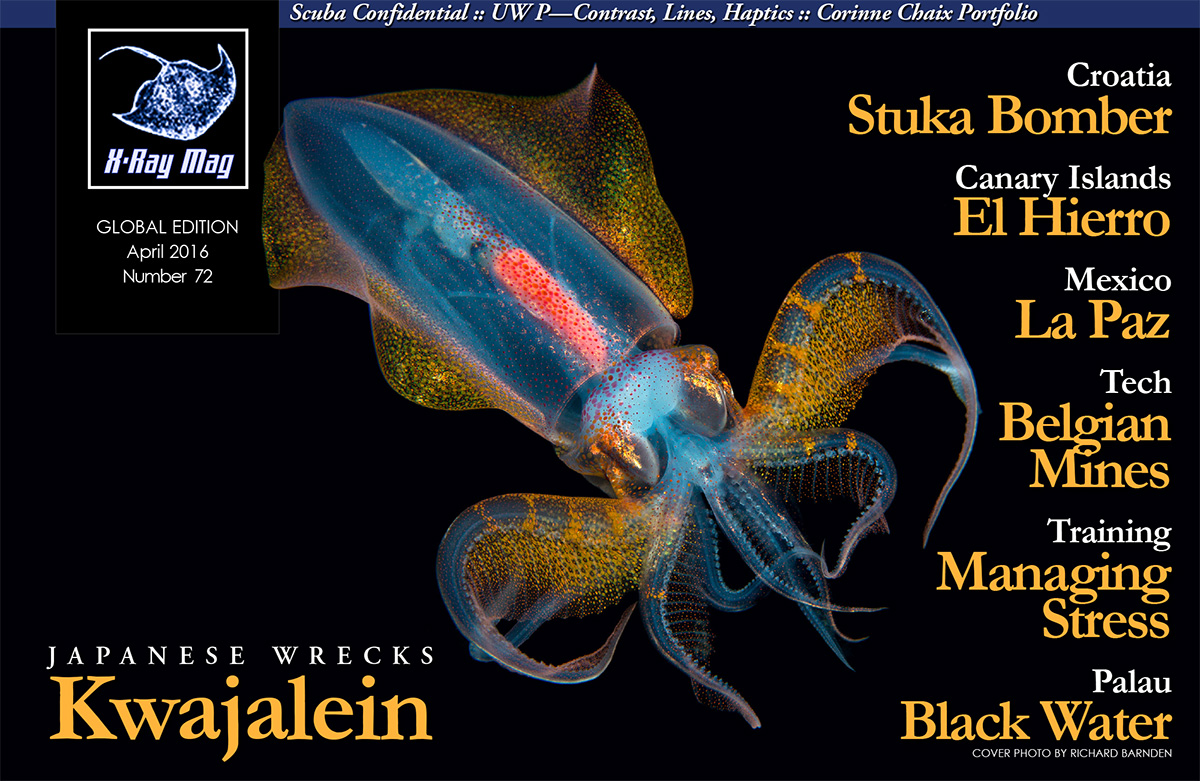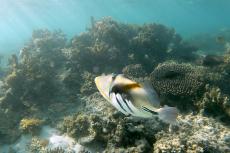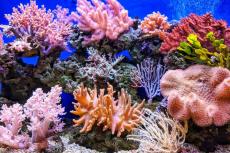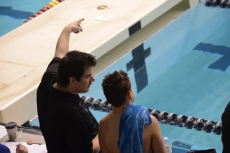Trip Teaser: Come with X-RAY MAG to Palau on the Palau Siren liveaboard!
Join X-Ray Mag editor Matthew Meier on this very special and different liveaboard cruise on the Palau Siren through the stunning archipelago of Palau in Micronesia.
Palau is famous for its large pelagic life, manta rays, grey reef sharks and swimming with millions of stingless jellyfish. But not many people are also aware that hidden beneath the waters of Palau’s inner lagoon lies some of the planet’s best wrecks from WW2.
How did some of Japan’s Combined Fleet end up resting on the sandy bottom of this pristine island? And how are Palau’s wrecks connected to the world-famous wrecks of Chuuk, also known as Truk Lagoon?
(Find specifics and booking info at the bottom of this page)
Contributed by
Trip highlights
- World War II wrecks
- 36 Japanese vessels, as well as sundry aircraft
- Steep walls with abundant fish life
- Manta Rays and Reef Sharks
- Stunning archipelago
- Luxury stay on Palau Siren
Guide: Matthew Meier
Background
In September 1940, the United States placed an embargo on Japan by prohibiting exports of steel, scrap iron and aviation fuel due to Japan’s recent takeover of Northern French Indochina. Eventually freezing all of Japan’s assets and thus preventing Japan from buying oil, the move intended to politically cripple the country’s army, navy and air force.
Pearl Harbor, Hawaii
On Sunday, 7 December 1941, the first wave of Japanese airplanes left six aircraft carriers on a mission to attack Pearl Harbor where the United States Fleet was anchored. Over 3,500 Americans were killed, 18 ships were sunk and over 350 aircraft were destroyed. In one strike, the Japanese Navy scored a brilliant success and at the same time assured their ultimate defeat. The Japanese attack brought the United States into the war, determined to fight to the finish and claim revenge for their public humiliation.
Admiral Isoroku Yamamoto
Yamamoto was credited as the mastermind behind the Japanese attack on Pearl Harbor. The Americans slowly sought revenge. Exactly one year after the Doolittle raid on the 18 April 1943, US secret intelligence had cracked the Japanese code giving away the admiral’s exact position. While flying over the Solomon Islands, the Mitsubishi G4M “Betty Bomber” in which the admiral was flying came under attack by American P38 Lightening aircraft and he was killed.
The Yamato—the admiral’s headquarters and the largest battleship ever constructed by any navy—remained anchored at Truk Lagoon and was soon to become one of America’s next targets.
Operation Hailstone
Operation Hailstone, launched on 16-17 February 1944, was a massive naval air strike and surface attack on Truk Lagoon. Truk was a major Japanese logistical base as well as the operating base for the Imperial Japanese Navy’s Combined Fleet and Japanese air base. Some have described it as the Japanese equivalent of the US Navy’s Pearl Harbor.
Prior to Operation Hailstone, a reconnaissance flight over Truk on February 4, 12 days before the attack was spotted by Japanese intelligence. Fearing the base was too vulnerable and that attack was imminent, Japan relocated their aircraft carriers, battleships and heavy cruisers of the Combined Fleet to Palau a week prior to Operation Hailstone.
Operation Desecrate One
On 30-31March 1944, Operation Desecrate One was a United States Navy operation against the Japan’s bases around Palau. It involved attacks by task force 58, once again with aircraft carriers USS Enterprise, USS Bunker Hill, USS Hornet, USS Yorktown, USS Lexington, USS Monterey, USS Belleau Wood, USS Cowpens, USS Cabot, USS Princeton and USS Langley—the same carriers that were involved in Truk Lagoon.
Just one month after Operation Hailstone in Truk, the Japanese were aware that the attack of Palau would be imminent. However, the speed at which the Americans organized such an attack and the amount of US Navy forces involved also led to another of Japan’s defeats.
Thirty-six Japanese ships were sunk or damaged in the attacks. TBMs and TBF Avengers from those carriers bombed extensive minefields in and around the channels and approaches to Palau in the first tactical use of mines laid by carrier aircraft.
Salvage
In the years following the war, the Japanese government was given permission to conduct salvage operations as a way to raise money to pay for war claims. Conducted by Fujita Salvage K.K. of Osaka, at least 15 wrecks or more were partially salvaged, some were even re-patched and floated. Scrap metal and artifacts were loaded onto some of the re-floated ships in order to tow them back to Japan to be sold. On the return voyage, the entire fleet was hit by a typhoon in the South China Sea and sank. Nothing ever returned back to Japan’s shores.
Palau wrecks
Although some wrecks have been salvaged and some artifacts removed compared with Truk, there are a handful of world-class wrecks that were either left untouched by the salvage company or simply not found until later.
Iro. Iro was launched on 5 September 1921 by Osaka Iron Work’s Sakurajima factory. Unlike the maru style of boat converted from a civilian ship, this boat was designed for warfare and therefore does not have maru in its title. The Iro was a Japanese navy fleet oiler. It was 140m (462ft) long, with a 17.6m (58ft) beam and weighed 14,050 tons.
On 22 March 1944, while in a convoy to Palau, a Gato-class submarine, USS Tunny, struck the bow of Iro, foreword of the bulk head, before disappearing into the depths. The Iro survives but limps into Palau only to be attacked by Operation Desecrate One on 31 March 1944.
TF 58 planes found and attacked the Iro, anchored in a sheltered lagoon close to Koror. Iro sustained a direct bomb hit in the engine room and was set on fire. Of the 250 soldiers on board, 200 survived, but Captain Kitamura was killed in action. The Iro burned for days before finally sinking on 17 April 1944.
Sitting upright on the bottom at 40m (132ft), with the bow at 20m (66ft), Iro makes a great recreational dive. Descending down the line you can start to see its coral-encrusted gun on a circular platform with a barrel diameter of 7 inches and a total length of 4.2m (14ft). Visibility can range from more than 30m (99ft) to around 10m (33ft) depending on the weather and wind direction. The port anchor is still in place. If you drop down on the starboard side and follow the starboard anchor chain to 30m (99ft), you can swim through the torpedo hole made by USS Tunny, which is now covered in black corals.
Sticking to the deck, behind the gun, is hold number one. Split into three levels, the first level holds a bathroom and toilet, with the bottom level containing wooden crates of sake bottles and gas masks peering out of the silt.
Continuing towards the stern, divers will pass the first kingpost with the bridge superstructure up ahead. Due to fire, the entire superstructure was burned out. However, some amazing hard table coral formations have now completely covered it.
On the starboard side, one can swim through the corridors leading to the crew quarters. After exiting, divers can continue towards the stern where a few holds further forward contain large oil drums used for storing oil. Up ahead is another superstructure leading to another part of the crew quarters, with bedsprings and a bathroom on the starboard side.
The last exit on the right side leads to the engine room where the boiler is still in place. This is also penetrable from the deck. The catwalks have been blown into a tangled mess from bomb destruction and salvage efforts. However, some good penetration diving can still be made down here. The port side of the ship is difficult to penetrate due to fallen debris blocking some of the entrances.
Exiting the engine room, divers make their way to the stern where another large gun identical to the bow gun is sitting. However, less coral formations grow here due to the slightly deeper depth of 30m (132ft) and there is poorer visibility at times.
Entering the capillary steering gear section directly below the stern gun, one can penetrate into some other interesting compartments containing more gas masks, rope, lanterns, books and probably a lot more items hidden in the heavily silted parts. As divers make their ascents, they can check out the anemone nests sitting near the top of the kingposts, as they make their way back to the mooring line.
Chuyo Maru. Built in 1943 and owned by Toyo Kisen Kaisha in Tokyo, the Chuyo Maru was a medium-sized coastal freighter, at a length of 89m (285ft), beam of 12.4m (40ft) and 1,941 tons. Although not a huge ship, the vessel is full of interesting artifacts.
Although the location of this wreck was known by salvagers, it was not thought to be worth salvaging and was generally forgotten until it was rediscovered by Francis Turibiong and Klaus Lindemann in 1989.
The bow is slightly raised above the main deck with a loading tower in the middle. On top of the forecastle is a double-headed anchor winch. On the port side of the deck are two anchors. It took our dive operation a while to find out how or why this was possible when we were informed that these were picked up and dropped by a passing superyacht by accident, while anchoring too close to the wreck.
The bridge superstructure was burned during the bombing. However, remains of the telegraph, which lies on its side, and brass compass, now completely encrusted by a red sponge but which is still standing, can be seen inside the bridge.
Continuing aft towards the stern, divers pass the main cargo holds, which are empty. However, one can do some nice penetration through the ship, finding some wheelbarrows on the port side and ending up either swimming through a narrow skylight or through the crew’s quarters into the boiler and engine rooms. Entering the crew’s quarters directly to the right, one can see a small galley, with rice pots and cooking bowls still standing.
Continuing around a horseshoe-like room, there are remains of a bed, ashtray and even vinyl records protruding from the silt. A single door on the starboard side leads to a catwalk and stairs that connect the deck to the engine room entrance.
Inside the engine room, which is fairly large and still intact, a set of spanners are on the wall at the bottom level just above the silt. Pots and pans are scattered around and even some human remains can be found hidden in the silt (please be respectful of these and do not touch).
Further aft towards the stern, a 4.7-inch,1.82-ton short gun stands in all its glory with four ammunition boxes and two depth charges sitting in the launchers, port and starboard side. As this wreck was never salvaged, it has reminiscences of diving Truk lagoon, with its excellent, still-intact engine room and interesting artifacts scattered around the wreck, making it one of Palau’s best wrecks.
Amatsu Maru. Built in 1943 by Mitsubishi, the Amatsu Maru was an auxiliary tanker and is the largest shipwreck in Micronesia, at 153m (502ft), 20m (65ft) beam and a little over 10,560 tons.
The Amatsu Maru was only partly salvaged after the war, as the salvage company originally decided to raise the ship. However, during an attempt to cut through its steel plates near the stern, the flame of the cutting torch hit trapped gases, setting off an explosion that killed two men. The Japanese then abandoned the salvage attempt, believing the accident to be a bad omen.
The bow is slightly raised above the main deck where there are ladders on both sides connecting it. From the bow, moving aft, toward the bridge, pipes, hoses and large valves used for loading and unloading the oil and fuel are visible. The bridge is constructed of three decks, the uppermost is the navigational deck, the second level is the communications center and the lower level shows fuel pipes leading through to the pump house. Some instruments can still be found on the second level. Here, communications control panels, still with rubber handles on them, can be seen as well as a safe with its door blown off, which now lies on the bottom level after some salvage. Urinals and toilets are also at the rear of the bridge area.
The bridge can be entered from above, between the support beams or through a small door on the starboard side deck. The main fuel storage area behind the bridge features a large piping system now covered with extensive marine growth.
A small square pump house, which must have been the control centre for pumping fuel, can be entered through a small door—not so much can be seen inside. However, it descends several levels down, and offers great photo opportunities. Both the center island and stern superstructures can be explored on at least three levels.
The Amatsu Maru was hit directly by several 1,000 lb bombs into the engine room. Diving through this section of the ship reveals huge piles of twisted metal, and one can only imagine the force of these bombs as one swims along into the now open area. Although this area is a complete mess, it is possible to find interesting still-intact parts and, again, great photo opportunities of light penetration can be achieved.
At the stern lies the twisted remains of a circular gun platform where the gun once stood. This has either been salvaged or completely blown off. Following the stern down to the sandy bottom reveals a huge four-bladed propeller lying intact on the bottom. Due to its sheer size and deep dive profile, it is recommended that you dive this wreck twice to cover all of the highlights. ■
Details
Liveaboard Vessel: Palau Siren
The 40 metre S/Y Palau Siren luxury liveaboard was launched in July 2012. She has the same specifications as her sister yachts, the S/Y Philippine Siren and the S/Y Indo Siren.
The cabins offer flexibility and can be used as twin or double-‐bedded rooms. The dining area is very spacious offering a great setting for all your meals. The dive deck is perhaps the most spacious and comfortable you would have experienced.
Designated areas for charging and preparation of your camera and video equipment, the S/Y Palau Siren, as all Siren Fleet yachts, truly sets out to be the pros choice for underwater photography and videography.
You will find no other dive liveaboard as beautiful in the waters of Micronesia, and being that she was built by divers for divers you can rest assured every need has been thought of and is being implemented. Aboard the S/Y Palau Siren we shall welcome up to 16 guests on each trip. This ensures abundant space for all divers.
Price per person € 4,875
Included in the price:
- Transfers Koror Airport – vessel r/t
- 10 nights in shared cabin with en-‐suite bathroom on board Palau Siren
- 3 meals a day, snacks, water, tea, coffee, soda and beer
- 9 days diving (3-‐4 dives a day) incl. guide, tank, weights, mask, fins, wet suit (3 mm shorty), regulator, BCD and SMB
- Free 32% Nitrox on board
Not Included in the price:
- International flights into Koror r/t
- Extra nights and transfers in Manila prior to or after the cruise
- Marine Park fees amounting to € 155 to be paid on board
- Departure tax USD 20 plus "Green fee" USD 30
- Rental of dive computer or lamps: € 5 pr item pr day
- Additional activities, gear rental, gases and meals not specified above
- Tips from guides and crew (recommended but not required)
Bookings and organiser:
Scuba Travel Scandinavia. For more information or to reserve your spot, email: info@scubatravel.se
Note: X-Ray Magazine does not handle bookings or requests about trip details. Please direct all inquiries to the organiser.
To download:
BROCHURE - Complete trip description and details (pdf)

